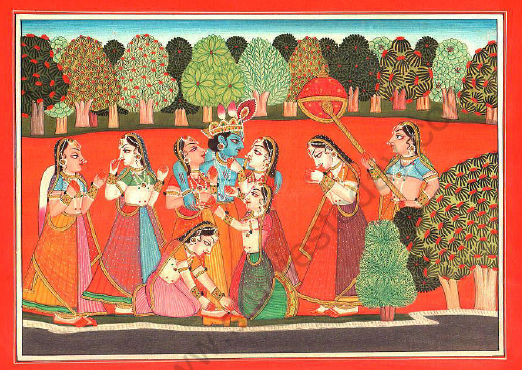
Embark on a vivid journey through the enchanting realm of Pahari School of Miniature Painting! 
- Kangra School of Miniature Painting:
The Kangra school, one of the most renowned sub-schools of Pahari painting, flourished in the Kangra Valley of Himachal Pradesh. It is known for its lyrical and romantic depictions of Radha and Krishna, capturing their divine love and spiritual longing. The delicate and graceful figures, subtle colour palette, and intricate detailing distinguish this school. Kangra miniatures often portray scenic landscapes and the use of transparent watercolours creates a luminous effect. The Kangra school reached its zenith under the patronage of Raja Sansar Chand of Kangra in the late 18th century.
- Basohli School of Miniature Painting:
The Basohli school, originating in the town of Basohli in Jammu and Kashmir, is considered one of the earliest sub-schools of Pahari painting. It is characterized by its bold and vigorous compositions, rich colors, and intense expressions. The Basohli miniatures often depict scenes from Hindu epics like the Ramayana and the Mahabharata, along with themes of love and devotion. The use of bright reds, greens, and yellows, as well as strong black outlines, contribute to the distinctiveness of the Basohli style.
- Guler School of Miniature Painting:
The Guler school emerged in the princely state of Guler in Himachal Pradesh. It is renowned for its elegant and refined portrayals of human figures, emphasizing grace and beauty. Guler miniatures often depicted scenes from the life of Krishna, along with themes of love and devotion. The use of soft and pastel colours, along with subtle shading, creates a delicate and ethereal appearance. The Guler school reached its peak during the reign of Raja Dalip Singh in the 18th century.
- Chamba School of Miniature Painting:
The Chamba school thrived in the Chamba region of Himachal Pradesh. It is known for its distinctive style, combining elements from both the Kangra and Basohli schools. Chamba miniatures often portray religious themes, royal portraits, and scenes of courtly life. The use of bright colors, intricate patterns, and attention to detail characterize this school. Chamba artists were skilled in depicting landscapes and architectural elements, adding depth and context to their compositions.
Each sub-school of Pahari painting holds a unique charm and artistic expression, contributing to the rich and diverse heritage of Indian miniature art.
The tendency to show a high horizon in Pahari school of miniature painting is a distinctive stylistic feature that sets it apart from other Indian miniature art forms. In Pahari miniatures, the horizon is often placed high on the canvas, leaving a significant portion of the artwork dedicated to the portrayal of the sky and celestial elements. This artistic choice creates a unique visual effect, giving the paintings a sense of expansiveness, grandeur, and otherworldliness.
One of the reasons behind this tendency is the artistic tradition’s connection to the region’s hilly landscape. The artists drew inspiration from the picturesque hills and mountains of the Pahari region, incorporating them into their compositions. By placing the horizon high, the painters could include more of the majestic landscapes in their works, showcasing the beauty of the mountains, valleys, and rivers.
Moreover, the high horizon added a sense of depth to the paintings. The vast expanse of the sky emphasized the subject’s importance and spiritual significance, often reflecting divine themes and celestial events.
An excellent example of this tendency can be seen in the Kangra school’s paintings, particularly in depictions of Radha and Krishna. In these works, the horizon is elevated, and the celestial beings are often placed against the backdrop of an expansive sky. For instance, in the painting of Radha and Krishna’s Raas Leela, the high horizon allows the artists to showcase the beauty of the moonlit night and the charming landscapes of Vrindavan. The heavenly setting complements the divine love and transcendental nature of the scene, evoking a sense of divine ecstasy.
In conclusion, the tendency to show a high horizon in Pahari school of miniature painting is a deliberate artistic choice that allows the artists to celebrate the region’s natural beauty and create an otherworldly atmosphere. This unique approach contributes to the captivating charm and spiritual essence that defines Pahari miniature art, making it an integral part of India’s rich cultural heritage.
